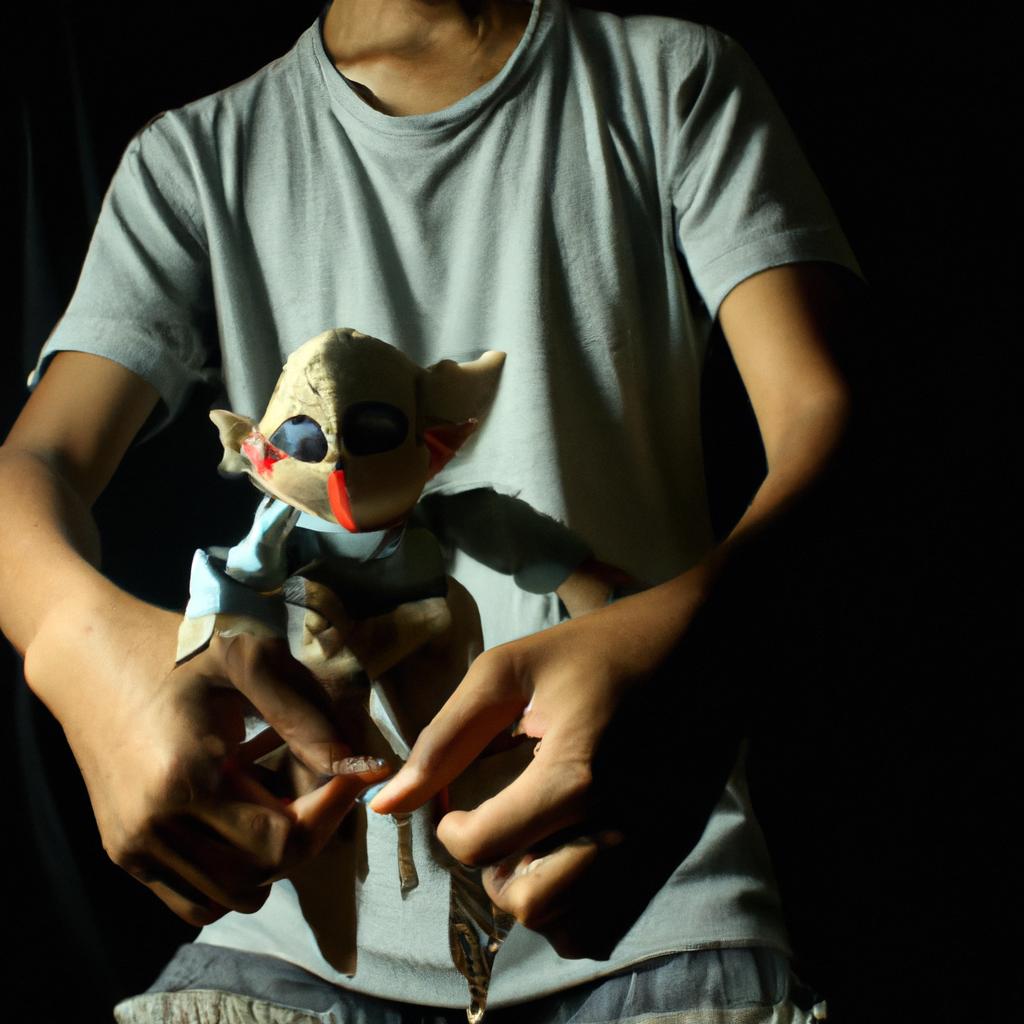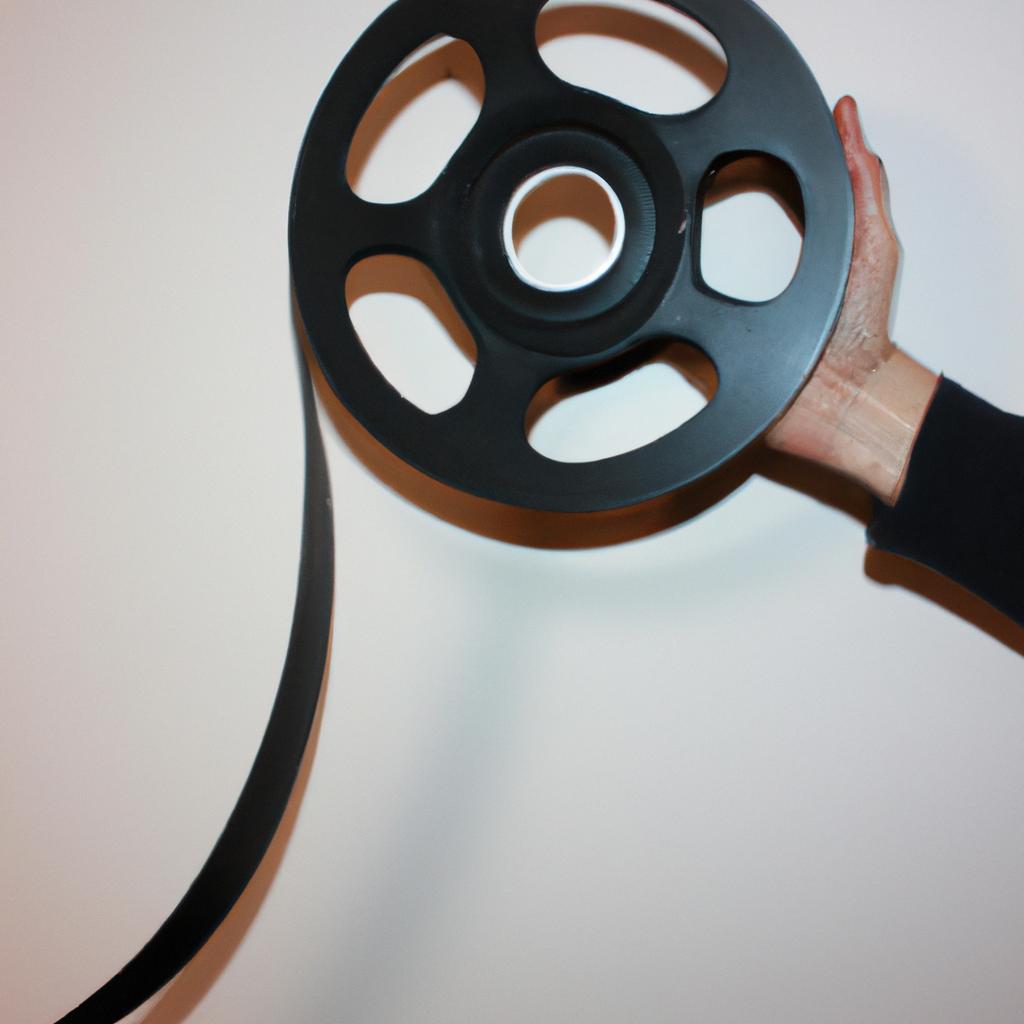Puppetry in the Context of Arts and Entertainment: An Informational Perspective

Puppetry, a centuries-old art form that combines storytelling, performance, and craftsmanship, has captivated audiences worldwide. Whether it be the intricate marionettes of France or the colorful shadow puppets of Southeast Asia, puppetry continues to be an integral part of arts and entertainment. In this article, we will explore puppetry from an informational perspective, examining its historical significance, cultural diversity, and contemporary relevance.
To illustrate the enduring appeal of puppetry within the realm of arts and entertainment, let us consider a hypothetical case study: The Great Puppet Theater Company. This innovative group reimagines classic fairy tales through visually stunning puppet performances. Utilizing various styles such as hand puppets and rod puppets, they create enchanting shows that blend traditional techniques with modern technology. Through their captivating storytelling and meticulous attention to detail in design and performance, The Great Puppet Theater Company showcases how puppetry can transcend time while remaining relevant to today’s audience.
With its roots stretching back thousands of years across different cultures around the globe, understanding the context in which puppetry thrives is essential for appreciating its artistic value. By delving into its rich history and exploring its diverse manifestations across continents and civilizations, we can gain insights into how puppetry has evolved over over time and become a cherished form of artistic expression.
In ancient times, puppetry was used for various purposes, including religious ceremonies, educational storytelling, and entertainment. For example, in Ancient Greece, puppets were employed in religious rituals to honor the gods and convey moral lessons. In Asia, specifically in China and India, puppetry became popular as a means of entertainment for both the elite and common people.
Throughout the Middle Ages and Renaissance periods in Europe, puppetry continued to evolve. Puppet shows were often performed at fairs and marketplaces, attracting crowds with their comedic antics and exaggerated characters. The advent of string-operated marionettes allowed for more intricate movements and realistic performances.
Cultural diversity is another fascinating aspect of puppetry. Different regions developed unique styles and techniques that reflected their specific traditions and aesthetics. For instance, Bunraku puppetry from Japan features large puppets operated by multiple skilled performers dressed entirely in black. This style emphasizes precise coordination between the puppeteers while conveying emotional depth on stage.
Shadow puppetry emerged independently in various parts of the world but is most commonly associated with Southeast Asia. Using intricately cut-out figures made from leather or paper, shadow puppeteers create beautiful silhouettes against a translucent screen or wall. This art form showcases the mastery of light manipulation to tell engaging stories with vivid visuals.
In contemporary times, puppetry remains relevant through its ability to adapt to new technologies while retaining its traditional charm. Modern advancements have introduced innovations such as animatronics and digital projection mapping into puppet performances. These techniques enhance the visual effects and create immersive experiences for audiences.
Furthermore, puppetry has found its place beyond theater stages. It has been utilized in film productions like Jim Henson’s beloved Muppets series or War Horse directed by Steven Spielberg. Additionally, it has been integrated into therapeutic practices for children with special needs or used as educational tools to engage young learners.
As we explore puppetry’s historical significance, cultural diversity, and contemporary relevance, it becomes evident that this art form continues to captivate audiences worldwide. Its ability to combine storytelling, performance, and craftsmanship makes puppetry a truly unique and enduring form of artistic expression. Whether through traditional styles or innovative adaptations, puppetry remains an integral part of the arts and entertainment landscape.
History of Puppetry
History of Puppetry
Puppetry, an ancient art form that dates back thousands of years, has served as a means of entertainment and storytelling in cultures across the globe. One fascinating example is the Bunraku puppetry tradition in Japan. Developed during the 17th century, it combines intricate wooden puppets operated by multiple puppeteers who skillfully manipulate their movements to bring characters to life on stage.
The history of puppetry can be traced back to ancient civilizations such as Egypt, Greece, and China. In Ancient Egypt, for instance, evidence suggests that puppets were used in religious ceremonies and rituals. Greek theater also incorporated puppets known as “klephts” into performances to represent mythical creatures or gods. Similarly, Chinese shadow puppetry emerged around 2nd century BCE and became renowned for its elaborate designs and expressive movements.
To provide a deeper understanding of the historical significance of this art form, consider these key points:
- Puppets have been made from various materials throughout history including wood, clay, fabric, and even paper mache.
- Different styles of puppetry have developed in different regions worldwide; each style carries its unique cultural characteristics.
- Puppeteers often employ specialized techniques like string manipulation (marionettes), hand control (glove puppets), or shadow projection (shadow puppets).
- The themes explored through puppetry range from comedy and satire to tragedy and social commentary.
| Puppet Materials | Styles of Puppetry | Techniques |
|---|---|---|
| Wood | Marionette | String Manipulation |
| Clay | Glove | Hand Control |
| Fabric | Shadow | Shadow Projection |
| Paper Mache | Rod | Direct Manipulation |
By examining the rich history and diverse forms of puppetry across cultures, we gain insight into the artistic and cultural significance of this art form. Understanding the materials, styles, and techniques used throughout history helps us appreciate the skill and craftsmanship involved in bringing puppets to life.
Transitioning into the subsequent section on “Types of Puppets,” we delve deeper into the intricacies of puppetry by exploring various types of puppets and their distinct characteristics.
Types of Puppets
Section Title: Evolution of Puppetry Techniques
The historical development of puppetry has paved the way for a multitude of techniques that are utilized in contemporary performances. One notable example is the use of shadow puppets, which originated in China during the Han Dynasty (206 BCE – 220 CE). Shadow puppetry involves manipulating cut-out figures made from translucent materials against a light source, creating intricate silhouettes and captivating visual effects.
Puppeteers have continuously refined their craft over time, resulting in an array of innovative techniques used to bring puppets to life on stage. These techniques can be categorized into three main types:
-
Manipulation-based Techniques:
- Marionette Puppets: These string-operated puppets require skilled manipulation by puppeteers who control their movement using strings attached to various parts.
- Rod Puppets: Controlled through rods or sticks held by puppeteers beneath them, these puppets offer greater mobility and flexibility compared to marionettes.
-
Body-Based Techniques:
- Hand Puppets: Also known as glove puppets, these small-scale puppets are worn on one hand with fingers serving as limbs.
- Bunraku Puppets: Originating from Japan, bunraku combines multiple puppeteers operating different body parts simultaneously to create realistic movements.
-
Object-Based Techniques:
- Shadow Puppets: As mentioned earlier, this technique employs flat cut-out figures manipulated behind a screen or curtain.
- Tabletop Puppets: Utilizing tabletops or platforms as stages, these puppets interact with objects around them, providing a more immersive experience.
These diverse techniques allow puppeteers to convey emotions and tell captivating stories through their artistry. With each technique offering unique possibilities for expression and engagement, audiences are transported into imaginative worlds where inanimate objects come alive before their eyes.
Transitioning seamlessly into the subsequent section about “Role of Puppetry in Storytelling,” the evolution and diversity of puppetry techniques have not only expanded the possibilities for artistic expression but also deepened its impact on storytelling. By harnessing these various techniques, puppets become powerful tools to convey narratives that resonate with audiences on a profound level.
Role of Puppetry in Storytelling
Puppetry in the Context of Arts and Entertainment: An Informational Perspective
Types of Puppets have been explored extensively in the previous section, shedding light on the various forms and structures that puppets can take. Building upon this foundation, it is crucial to understand the significant role puppetry plays in storytelling, as it seamlessly combines elements of performance, artistry, and imagination.
To illustrate this point further, let us consider a hypothetical scenario where a group of puppeteers stages a production based on a classic fairy tale. The use of hand puppets brings characters like Cinderella and her evil stepmother to life on stage. Through intricate movements and gestures controlled by skilled puppeteers, these figures effortlessly convey emotions such as joy, despair, or anger. As spectators watch with anticipation, they become deeply immersed in the narrative unfolding before them, forging an emotional connection with both the story and its captivating protagonists.
The impact of puppetry extends beyond mere entertainment value; it has profound implications for audience engagement. Here are some ways puppetry enhances storytelling:
- Elevating Visual Appeal: Puppets offer visually stunning displays that engage multiple senses simultaneously. Their vibrant colors, expressive features, and carefully crafted costumes captivate viewers’ attention from every corner of the theater.
- Fostering Imagination: By suspending disbelief through imaginative narratives enacted by puppets, audiences are transported into fantastical worlds where anything becomes possible. This sparks creativity within viewers’ minds and encourages them to think outside conventional boundaries.
- Facilitating Emotional Connection: Puppet performances often evoke strong emotions among spectators. The vulnerability conveyed by delicate marionettes or the lifelike expressions captured by animatronic puppets allow individuals to connect empathetically with fictional characters.
- Promoting Cultural Understanding: Puppetry transcends cultural barriers by showcasing diverse traditions and stories from around the world. Exposing audiences to different cultures fosters mutual respect, empathy, and a broader understanding of humanity’s rich tapestry.
To emphasize the profound impact puppetry has on storytelling, consider the following table:
| Puppetry in Storytelling | Emotional Response |
|---|---|
| Vivid visual displays | Awe |
| Immersive narratives | Enchantment |
| Emotionally expressive | Empathy |
| Cultural diversity | Appreciation |
As we delve deeper into Puppetry Techniques and Manipulation, let us explore the intricate methods employed by puppeteers to bring their creations to life. By examining these techniques, we can gain a comprehensive understanding of the craftsmanship behind this age-old art form and its ability to captivate audiences worldwide.
Puppetry Techniques and Manipulation
Building upon the understanding of puppetry’s role in storytelling, it is essential to explore the various techniques and manipulation methods employed by puppeteers. This section will delve into the intricacies behind these practices, shedding light on how they contribute to the overall impact of a puppet performance.
To illustrate the complexities involved in puppetry techniques, let us consider an example scenario where a marionette artist brings life to a wooden figure named Alessandro. Through meticulous string manipulation combined with skillful hand movements, the artist enables Alessandro to express emotions such as joy, sadness, or anger. The combination of precise control over strings and subtle gestures allows for a captivating portrayal that captivates audiences young and old alike.
When exploring puppetry techniques and manipulation, several key aspects come into play:
- String Control: Puppeteers masterfully maneuver strings attached to their puppets to bring them to life. By skillfully controlling tension levels and movements, they can create fluid motions that mimic human actions with remarkable accuracy.
- Hand Gestures: Beyond string manipulation, puppeteers utilize their hands directly to convey specific gestures that enhance character expression. From delicate finger movements mimicking intricate tasks to broad sweeping motions indicating grand gestures, each gesture contributes to conveying the intended message.
- Facial Expressions: A crucial element in engaging an audience emotionally lies within a puppet’s ability to communicate through facial expressions. Puppeteers employ specialized mechanisms such as movable eyes or mouthplates controlled by rods or wires to achieve nuanced portrayals of happiness, surprise, or even disappointment.
- Sound Effects: To further immerse spectators in the performance, sound effects are often incorporated alongside visual cues during puppet shows. Whether simulated footsteps echoing through a stage or meticulously crafted dialogue uttered through hidden speakers – these auditory elements complement the visual experience.
By utilizing these techniques along with others not mentioned here, skilled puppeteers create a multi-dimensional performance that resonates deeply with audiences. The following table exemplifies the emotional impact of puppetry techniques:
| Puppetry Technique | Emotional Response |
|---|---|
| Fluid String Control | Sense of Grace and Elegance |
| Expressive Hand Gestures | Connection and Understanding |
| Nuanced Facial Expressions | Empathy and Identification |
| Immersive Sound Effects | Enchantment and Captivation |
As we explore further into the world of puppetry, it becomes evident how these techniques contribute to its enduring appeal. In the subsequent section about “Puppetry in Film and Television,” we will delve into how this art form has transcended traditional stages to captivate audiences through different mediums.
With an understanding of the intricate techniques employed by puppeteers, let us now examine their adaptation in film and television productions without skipping a beat.
Puppetry in Film and Television
Section H2: Puppetry Techniques and Manipulation
Through their unique ability to captivate audiences and bring characters to life, puppets have become integral components of visual storytelling.
Puppetry in Film and Television:
One fascinating example that highlights the impact of puppets in film is Jim Henson’s beloved creation, Kermit the Frog. Introduced in “The Muppet Show,” Kermit quickly became an iconic character known for his witty banter and endearing personality. Despite being a simple hand-operated puppet, Kermit resonated with audiences worldwide through his relatable experiences and heartfelt emotions.
To further showcase the diverse applications of puppetry in entertainment media, consider the following emotional responses evoked by puppets:
- Laughter: Puppets often serve as sources of comedic relief, delivering punchlines and physical gags that elicit genuine laughter from viewers.
- Nostalgia: Familiar puppet characters evoke nostalgic feelings among audiences who grew up watching them on screen or stage.
- Empathy: Puppets possess a remarkable ability to create connections between fictional characters and real-life experiences, allowing viewers to empathize with their struggles and triumphs.
- Wonderment: The imaginative nature of puppetry can transport viewers into fantastical worlds filled with awe-inspiring creatures, sparking wonderment and curiosity.
| Emotional Response | Description |
|---|---|
| Laughter | Puppets serving as comedic relief |
| Nostalgia | Eliciting nostalgic feelings among viewers |
| Empathy | Creating connections between characters and audience |
| Wonderment | Sparking awe-inspired reactions through imaginative world-building |
In conclusion, puppets play an essential role in enhancing storytelling within film and television. Through their ability to evoke laughter, nostalgia, empathy, and wonderment, puppets create lasting emotional connections with audiences. This segment has explored just a glimpse of the impact that puppetry can have on entertainment media, setting the stage for the subsequent section on the influence of puppetry on cultural heritage.
Moving forward from exploring puppetry’s role in film and television, we now delve into the profound impact it holds on cultural heritage.
Impact of Puppetry on Cultural Heritage
Building upon the significance of puppetry in film and television, this section explores the profound impact that puppetry has on cultural heritage. By examining its role as a form of artistic expression and entertainment, we can gain insights into how puppetry helps preserve traditions and narratives.
Puppetry possesses an inherent ability to bring stories to life through captivating performances. For instance, let us consider the case study of ‘The Puppet Theater of Prague.’ Established in the 18th century, this renowned theater company continues to enchant audiences with their traditional Czech marionette shows. Through skillful manipulation techniques, these puppets convey emotions and actions just like human actors would. This example highlights how puppetry transcends language barriers, enabling cultural exchange and fostering appreciation for diverse art forms.
To further comprehend the impact of puppetry on cultural heritage, it is essential to recognize its significance within different societies. Here are four key aspects:
- Cultural preservation: Puppetry serves as a vessel for preserving indigenous stories, folklore, and historical events that may otherwise fade away over time.
- Ritualistic practices: In various cultures worldwide, puppets play integral roles in religious ceremonies or rites of passage.
- Education and socialization: Puppets serve as effective tools for teaching morals, values, and societal norms to younger generations.
- Community engagement: Puppet performances often act as communal gatherings where individuals come together to celebrate shared traditions.
Table: Examples of Cultural Heritage Preserved by Puppetry
| Culture | Tradition Preserved |
|---|---|
| Japanese | Bunraku – Traditional puppet theater that depicts historical tales |
| Indian | Kathputli – String marionettes showcasing myths and legends |
| Indonesian | Wayang Kulit – Shadow puppets narrating Ramayana epic |
| Mexican | Marionetas de Toluca – Colorful handcrafted dolls depicting local customs |
This section has highlighted the diverse ways in which puppetry contributes to cultural heritage. By showcasing captivating performances, preserving indigenous traditions, and fostering community engagement, this ancient art form continues to thrive across different societies. Through its ability to transcend language barriers and evoke emotions, puppetry serves as a powerful tool for storytelling and intercultural exchange. As such, it is imperative that we recognize and support the preservation of puppetry as an integral part of our collective human heritage.






